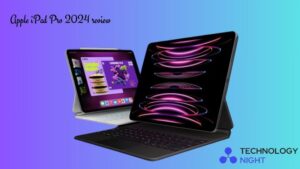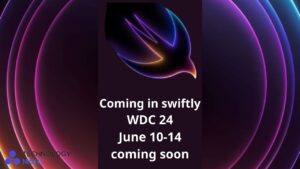
Table of Contents
Asus ROG Zephyrus G14 (2024)
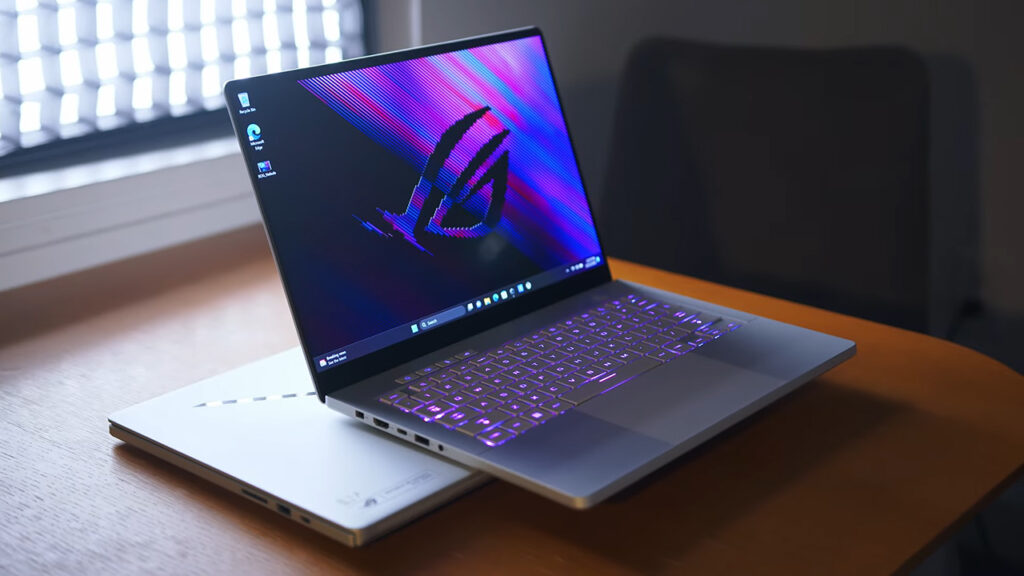
- Processor: AMD Ryzen 9 8945HS (8 cores, 16 threads, running at 4GHz with a maximum boost up to 5.2GHz)
- Graphics: Nvidia RTX 4060 mobile (dedicated) and AMD Radeon 780M onboard graphics
- Memory: 16GB DDR5 running at 6400MHz (non-upgradable)
- Storage: 1TB PCIe 4.0 NVMe M.2 SSD
- The display is a 14-inch OLED panel with a resolution of 2880 x 1800 and a 120Hz refresh rate. It offers a brightness of 500 nits according to specifications, and 410 nits as measured. The screen covers 100% of the DCI-P3 color gamut, has a response time of 0.2 milliseconds, is compatible with Nvidia G-Sync, and supports Dolby Vision HDR.
- Battery life: 12 hours
We never imagined a gaming laptop would become the top laptop on the market, but that day has come. The Asus ROG Zephyrus G14 is an exceptional computer with a stunning design, a vibrant 2K OLED screen, one of the most powerful processors out there, and a battery life of up to 12 hours, all housed in a sleek, lightweight, all-metal casing.
Priced at $1,600, the ROG Zephyrus G14 offers far better value compared to rivals such as the Dell XPS 14, Razer Blade 14, and the MacBook Pro 14.
The main trade-off with the ROG Zephyrus G14 is the lack of a well-known brand name.
However, it matches its competitors in luxury, efficiency, and overall enjoyment.
The ROG Zephyrus G14 has one notable limitation: its graphics performance.
While its Nvidia RTX 4060 graphics card is excellent for most productivity tasks, including 3D modeling in Blender or playing games like Cyberpunk 2077 with ray tracing, it may not be enough if you desire a refresh rate above 120Hz or the most powerful graphics card available.
In that case, you should consider the 2023 ROG Zephyrus G14 lineup or the larger ROG Zephyrus G16.
If you don’t require a discrete graphics card, consider opting for more affordable productivity laptops such as the HP Pavilion Plus 16 or the LG Gram 17.
However, if your laptop usage is split between drafting history papers and indulging in grand strategy games, the ROG Zephyrus G14 is the ideal choice.
This laptop ensures strong performance and impressive battery life, all at a significantly lower cost compared to other options.
Pros
- Fantastic performance
- Gorgeous OLED screen
- 12-hour battery life
Cons
- Soldered on memory
- A lower number of graphics card configurations compared to past years
Acer Swift Go 16 (2023)
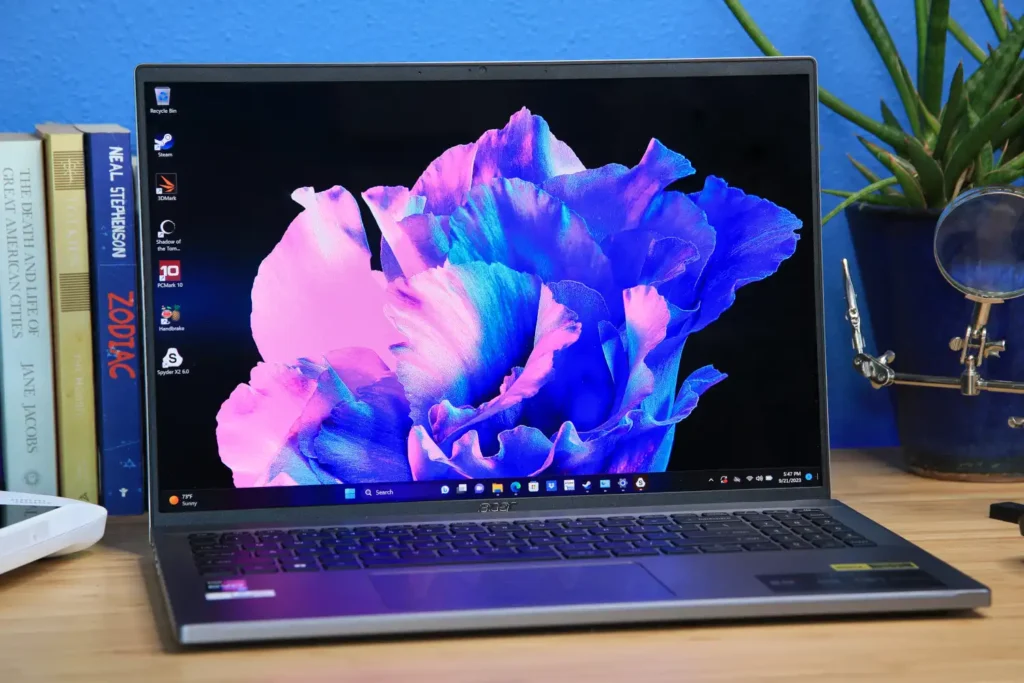
- Processor: Intel Core i7-13700H
- Graphics: Iris Xe Graphics
- Memory: 16GB LPDDR5 6400MHz
- Storage: 1TB SSD
- Screen: 16-inch, 3200 × 2000 resolution, 120Hz OLED
- Battery: ~7.4 hours
If an Intel 13th-gen processor and an OLED display are essential for you, consider Acer’s Swift Go 16.
This laptop boasts a sleek and shiny appearance akin to a MacBook, comes with a large trackpad and a decent keyboard and stands out as one of the thinnest and lightest options both on this list and in the market.
It’s also among the quickest productivity laptops we’ve tested so far.
Its processor competes with or even surpasses Apple’s MacBook Pro 14 M2 Pro in certain tests, effortlessly handling extensive Excel spreadsheets filled with intricate formulas and thousands of rows of data.
The Swift Go 16’s integrated graphics are capable of handling light gaming and can render basic 3D graphics at speeds comparable to some of the more advanced M1 and M2 MacBooks.
This thin and lightweight laptop offers a great deal of performance and versatility.
Pros
- Great productivity performance
- Solid, yet lightweight chassis
- Great touchpad, and a decent keyboard
Cons
- The OLED screen doesn’t achieve high brightness levels.
- Can run warm
The MacBook Air 13 M3 comes with a full array of features and amenities.
BEST MACBOOK
Apple MacBook Air 13 M3 (2024)
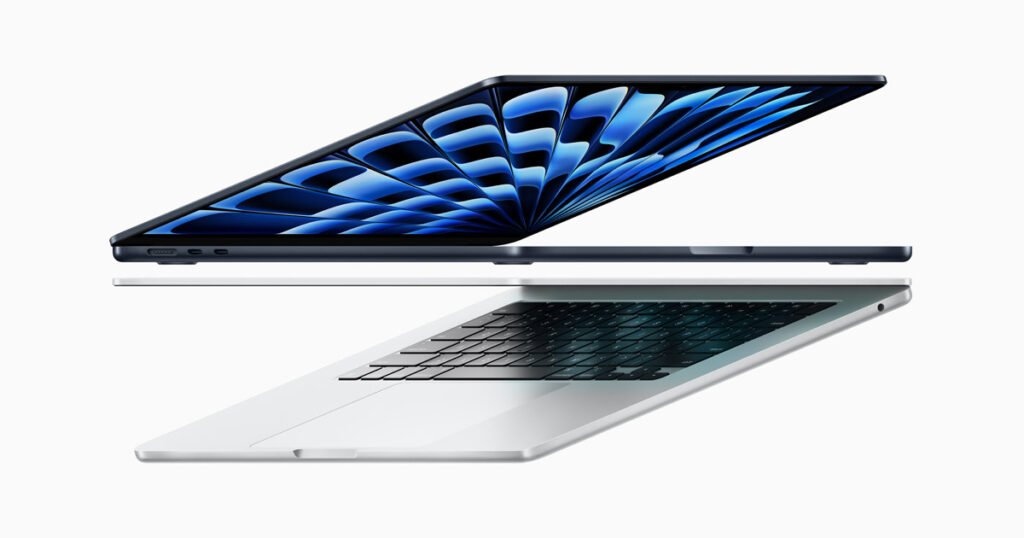
- Processor: Apple M3 with an 8-core configuration, including 4 performance cores and 4 efficiency cores.
- Graphics: Apple M3 10-core (integrated)
- Memory: 16GB LPDDR5x, unified
- Storage size: 512GB SSD
- Certainly! Here’s a paraphrased version of the given paragraph: Screen: 13.6 inches with a resolution of 2560 x 1644, rated at a maximum brightness of 500 nits (measured up to 518 nits), featuring 100% DCI-P3 color gamut and an LED display.
- Battery life: 10+ hours
Apple’s MacBook Air 13 M3 excels in various aspects. It boasts impressive speed, remarkable portability, and a stunning display within a sleek design, it offers a battery life that can exceed 10 hours.
All this comes while being one of Apple’s most affordable laptop options.
With its M3 processor, it exceeds the performance of most Windows productivity laptops in its price segment.
Additionally, its 2K display’s HDR compatibility gives it a visual appeal comparable to the finest OLED screens available from other brands.
The only drawback of the Apple MacBook Air 13’s M3 processor is its graphics performance.
While it is adequate for everyday tasks and light creative work, it falls short compared to the integrated graphics found in the latest processors from Intel and AMD.
Despite this, more powerful laptops usually tend to be larger, have shorter battery life, or both, compared to the MacBook Air 13 M3.
It’s one of the best laptops available, and it holds its own against the pricier MacBook Pro models without any envy.
Pros
- Thin, lightweight body
- Excellent audio
- Bright display
Cons
- Slow SSD performance
- Marginal upgrade over last gen
- Average battery life
BEST GAMING LAPTOP
Asus ROG Strix G18 (2023)
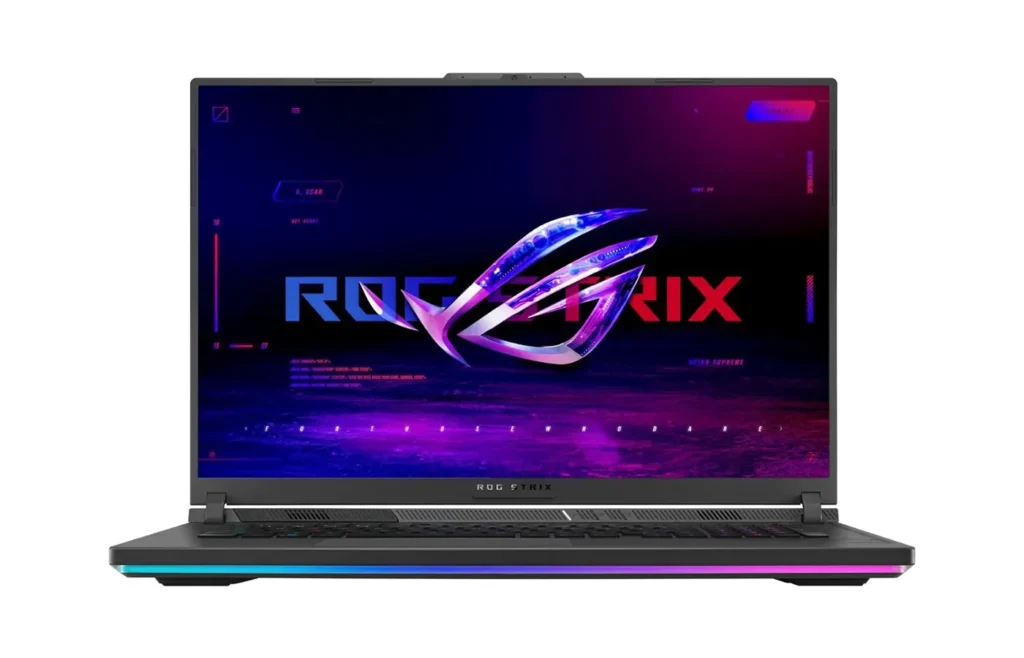
- Processor: Intel Core i9-13980HX
- Graphics: Nvidia RTX 4070
- Memory: 16GB LPDDR5
- Storage: 1TB SSD
- Screen: 18 inches, 2560 x 1600 resolution, 240Hz refresh rate, IPS LCD panel
- Battery life: 9.5+ hours
The Asus ROG Strix G18 is an excellent choice for both gaming and productivity.
While its 18-inch screen may not match the quality of OLED or mini-LED displays, it excels in color accuracy and motion clarity without the high price tag.
The screen is also bright enough to be easily used in well-lit environments.
This laptop includes Nvidia Optimus technology, which allows the system to switch off the Nvidia GPU when it’s not needed and use the more energy-efficient Intel-integrated graphics instead.
As a result, the battery life extends to over nine hours for less demanding activities like web browsing and video streaming.
The build quality is decent and aligns with the laptop’s price point; Asus chose to use lower-cost plastics that appear and feel less impressive compared to competitors like the Razer Blade 16.
However, considering the high performance you get for the price, this is a relatively minor trade-off.
Pros
- Excellent CPU and GPU performance
- Surprisingly long battery life
- Competitive Pricing
Cons
- Basic design
- Weak speakers
- 720p webcam
The HP Pavilion 16 is an outstanding laptop, perfect for handling surprises.
BEST 2-IN-1 LAPTOP
HP Pavilion Plus 16 (2023)
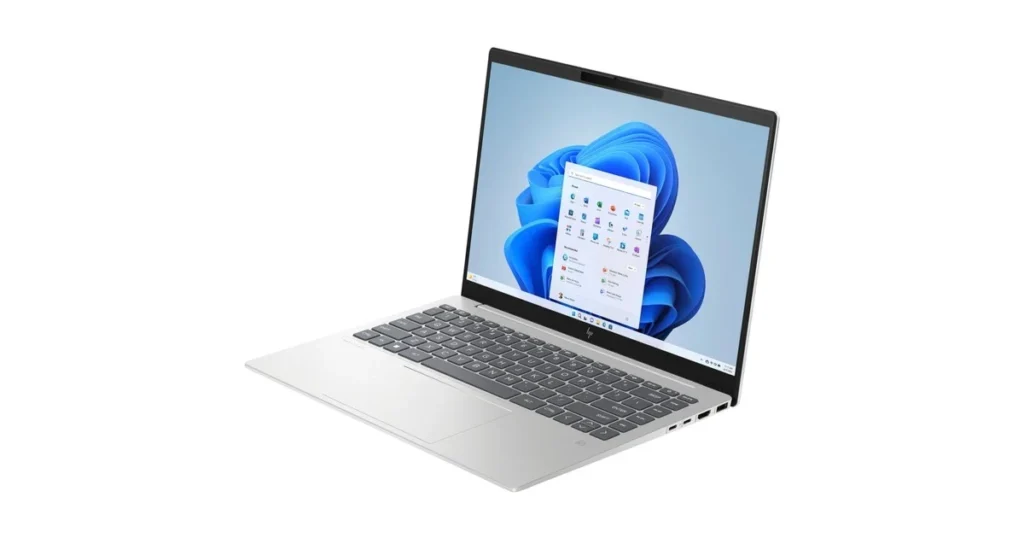
- Processor: Intel Core i5-13500H
- Graphics Options: Intel Iris Xe (integrated) and Nvidia GeForce RTX 3050 6GB (dedicated)
- Memory: 16GB LPDDR5x 5200MHz
- Storage: 512GB M.2 PCIe 4.0 with TLC
- Screen: 16 inches, resolution of 2560 x 1600, maximum brightness of 400 nits (rated); 458.1 nits (measured), variable refresh rate ranging from 48 to 120Hz, IPS panel with anti-glare technology
- Battery life: 13+ hours
The HP Pavilion Plus 16 offers all the features you could desire in a daily-use laptop.
It boasts a 13-hour battery life comparable to the MacBook Air 15 M2, discrete graphics capable of running most contemporary games, a vibrant 16-inch 2K screen, and ample memory and storage space. There’s hardly anything more you could ask for.
The Pavilion Plus 16 has a manufacturer’s suggested retail price (MSRP) of around $1,100, but you can frequently find it on sale for $800 or less. When compared to competitors such as the Dell Inspiron 14 Plus and the Lenovo Legion Slim Pro 7, it offers superior value.
Equipped with an Intel Core i5-13500H processor and an Nvidia RTX 3050 graphics card, this laptop delivers ample performance for productivity tasks and is also well-suited for casual gaming and content creation.
Unfortunately, the laptop makes some compromises to deliver high performance and many features within its design.
The keyboard, although functional, has soft keys and a strange arrow key layout.
While variable refresh rate (VRR) sounds good in theory, the VRR panel is too slow to adapt to varying refresh rates, resulting in a choppy user experience.
Additionally, switching between discrete and integrated graphics is cumbersome due to HP’s lack of command software, requiring you to manually select the graphics processor each time you open a new application.
For the majority, the imperfections are minor criticisms rather than decisive drawbacks.
The HP Pavilion Plus 16 remains a highly powerful, stylishly crafted, and reasonably lightweight laptop, featuring an excellent display and extraordinary battery life, all at an unmatched price.
Pros
- Great performance and battery life
- Bright and clear display
- Slim design
Cons
- So-so keyboard
- No simple GPU toggle
Other Laptops We Tested
Apple MacBook Pro 16 M3 Max (2023)
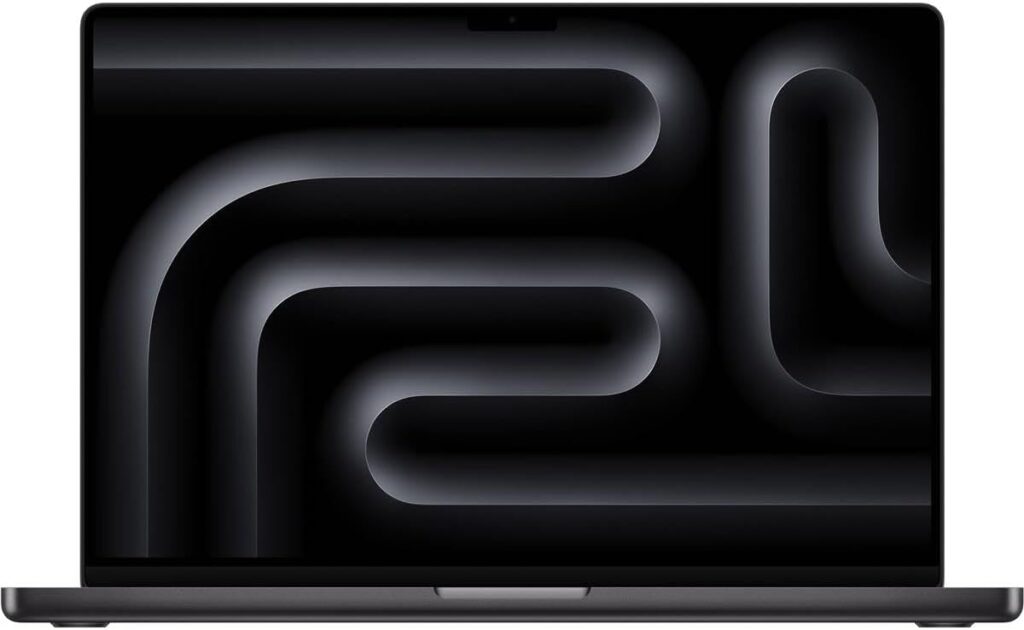
- Processor: Apple M3 Max, featuring 16 cores (12 dedicated to performance and 4 optimized for efficiency), with a clock speed of 4.05GHz.
- Graphics: Integrated Apple M3 Max with 40 cores, featuring hardware-accelerated ray tracing.
- Memory: 48GB unified
- Storage: 1TB SSD
- Screen: 16.2 inches, resolution of 3456 x 2234, brightness of 600 nits (SDR), 1,000 nits (sustained HDR), peak brightness of 1,600 nits (HDR), and refresh rate up to 120Hz, featuring Liquid Retina XDR technology.
- Battery life: 17.5+ hours
Despite its hefty $4,000 price tag, the MacBook Pro 16 M3 Max delivers unparalleled battery life, performance, memory, display quality, and ergonomics.
If budget is not a concern, this is undoubtedly the best laptop available.
The MacBook Pro 16 M3 Max excels in core processing power, but its exceptional graphics performance differentiates it from other MacBooks and surpasses most other laptops.
The 40-core graphics processor outperforms discrete graphics found in Windows laptops, such as the Nvidia RTX 4070, and its specialized media engines provide advantages in video editing, graphic design, rendering, and other demanding graphics tasks.
Combined with an HDR-compatible display, this laptop is a formidable choice for content creation.
Unfortunately, there’s a downside to all that power: portability.
While the MacBook Pro 16 M3 Max is quite sleek for a 16-inch laptop, it still tips the scales at nearly 5 pounds, making it a bit of a burden to carry around.
On the bright side, you can leave the charger at home because the battery lasts over 17 hours.
Another concern with the MacBook Pro 16 M3 Max is its operating system, macOS.
While macOS offers great utility and a user-friendly experience, professional creatives frequently use various programs that might not be compatible with it.
For such scenarios, a high-end Windows laptop like the Dell XPS 16 or Razer Blade 16 would be a more suitable option.
If macOS isn’t an issue for you, then you’ll love the MacBook Pro 16 M3 Max.
Its performance is hard to beat among Windows PCs, and even fewer can rival its battery life and design.
Pros
- Beautiful Space Black colorway
- Long battery life
- Remarkable performance of integrated graphics
Cons
- Still collects lots of fingerprints
- Still many barriers to Mac gaming
LG Gram 17 (2023)
- Processor: Intel Core i7-1360P
- Graphics: Nvidia RTX 3050
- Memory: 16GB DDR5
- Storage: 1TB NVMe PCIe SSD
- Screen: 17 inches, 2560 x 1600 resolution, 60Hz IPS featuring variable refresh rate (VRR)
- Battery: 14.5+ hours
As we mentioned in our review, the LG Gram 17 is “a sensible option for those seeking a large-screen performance laptop without an exceptionally high price.”
For a 17-inch laptop, it’s surprisingly lightweight, tipping the scales at around 3 pounds and measuring just over half an inch in thickness.
Despite the constant influx of slim and light laptops into the market each year, it’s rare to come across models that are both large in size and easy to carry.
Larger laptops are typically equipped to manage more intensive tasks, and although this Gram isn’t a full workstation, its processor is capable of tackling more demanding productivity chores such as video editing.
Its RTX 3050 graphics card allows you to play demanding video games at High or lower graphics settings.
Pros
- Fast processor and SSD
- Large and bright display
- Long battery life
Cons
- A touch too light
- Could use some more ports
Lenovo Yoga Book 9i (2023)
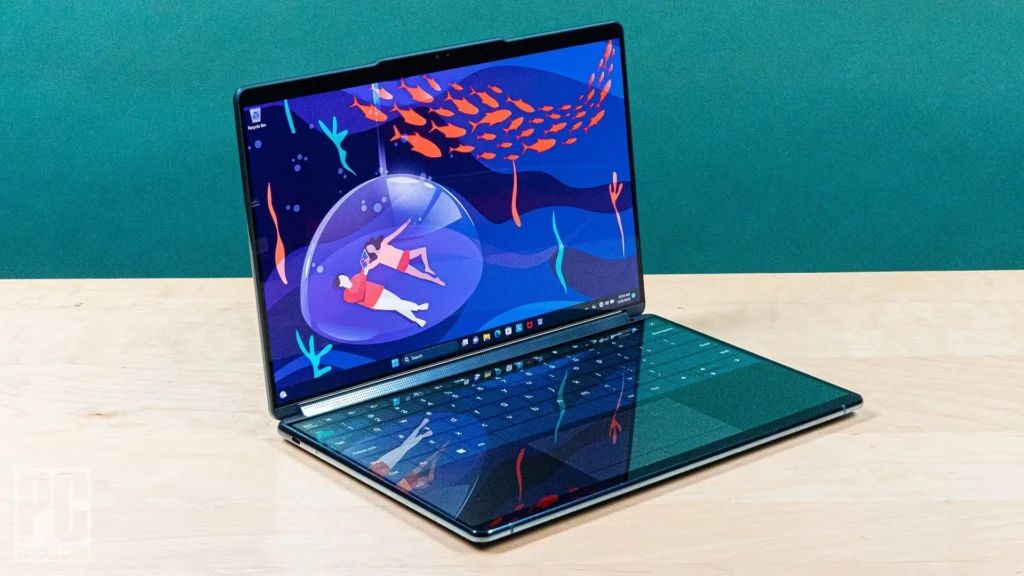
- Processor: Intel Core i7-1355U
- Graphics: Intel Iris Xe
- Memory: 16GB LPDDR5X
- Storage: 512GB SSD
- Screens: Two 13.3-inch OLED touchscreens with a resolution of 2880 x 1800, a refresh rate of 60Hz, and compatibility with a stylus for touch input.
- Battery life: 12.5 hours
The versatility, unique design, and outstanding performance of the Lenovo Yoga Book 9i truly impressed us.
Its dual-screen OLED display can adapt to various activities such as typing, drawing, researching, gaming, browsing on dual screens, and taking notes.
All these functions are easily managed with just a few simple accessories included in the package and pre-programmed custom touch gestures.
The physical keyboard cover can also function as a laptop stand for the Yoga Book 9i, allowing it to support dual-screen mode both horizontally and vertically.
When positioned vertically, the two screens can act as one large display, making it particularly handy when connected to a desktop monitor.
If you prefer not to use the virtual trackpad, Lenovo provides a physical trackpad and a stylus. Nevertheless, the touch displays are consistently responsive and precise.
Additional features include a sound bar integrated into the laptop’s central hinge, ensuring clear and loud audio regardless of the display’s orientation or form.
The OLED provides color accuracy and gamut coverage that are sufficiently precise for professional photo and video tasks, though it may not handle highly processor-intensive workloads.
Another laptop similar to the Yoga Book 9i is the Asus Zenbook Duo, both featuring dual OLED touch screens.
The Yoga Book 9i is priced a few hundred dollars higher than the Zenbook Duo; however, it offers 2K resolution displays, while the Zenbook Duo comes with 1200p resolution screens.
Pros
- Transforms
- Compact and portable
- Versatility
Cons
- Finicky touch gestures
- Takes some getting used to
Asus Zenbook Duo UX8406 (2024)
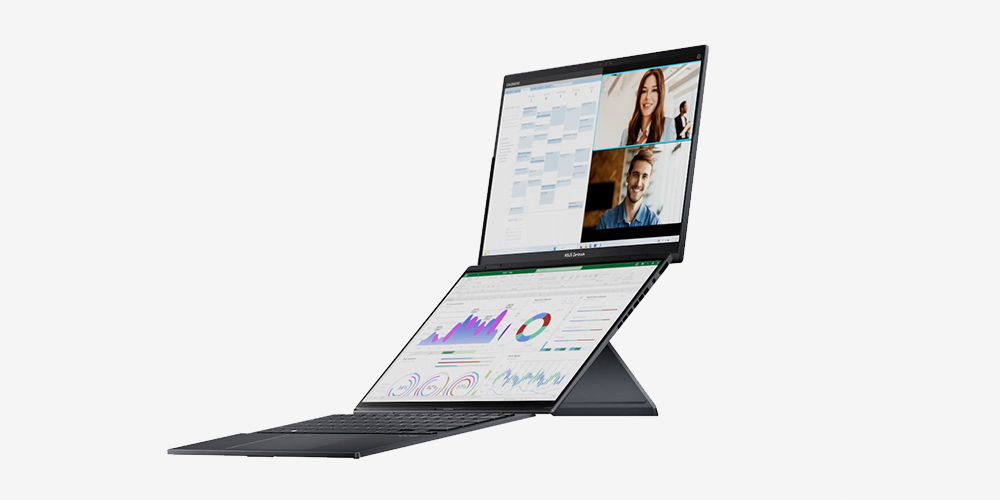
- Processor: Intel Core Ultra 7 155H, featuring 16 cores and 22 threads, with a boost clock speed reaching up to 4.8GHz
- Graphics: Intel Arc integrated graphics
- Memory: 16GB LPDDR5X 7467 MHz
- Storage: 1TB solid-state drive (SSD) with M.2 NVMe PCIe 4.0 interface.
- Screen: Dual 14-inch OLED displays with a resolution of 1,920 x 1,200 each, both featuring touch support and a 60Hz refresh rate.
- Battery life: 14.5 hours
The Asus Zenbook Duo is an impressive laptop that features a 17-inch dual-screen display, comes with a separate keyboard, and offers all the capabilities of a traditional laptop.
What’s more, it’s priced at just $1,500, making it significantly more affordable than other dual-screen laptops on the market.
The dual-OLED displays on this laptop are connected by a hinge, giving it the look and feel of a dual-screen PC.
With a detachable keyboard and an active stylus, you can enhance its capabilities and avoid solely depending on the touch screen.
Moreover, placing the keyboard over the lower display transforms the Zenbook Duo into a standard 14-inch laptop.
As is the case with any emerging technology, there are a few drawbacks.
The Zenbook Duo performs adequately for everyday productivity tasks, but it doesn’t offer exceptional value for the cost.
Comparable traditional laptops, such as the Apple MacBook Air M3 or the Acer Swift X 14, offer significantly higher performance.
The only laptop similar to the Zenbook Duo is the Lenovo Yoga Book 9i.
While the Asus Zenbook Duo features a lower-resolution display in comparison to the Lenovo Yoga Book 9i, it offers a bit more power.
However, if you’re seeking an uninterrupted display, the Asus Zenbook Fold 17 OLED and the Lenovo Yoga Thinkpad X1 Fold are worthwhile options to explore.
If the thought of having dual screens readily available appeals to you, the Zenbook Duo is a decent option despite its imperfections.
It might not shine in terms of performance or comfort, but it performs adequately to compete with more traditional choices.
Pros
- The dual-screen concept works well
- Can also function as a “regular” laptop
- Good value
Cons
- Touchscreens alone don’t qualify a device as a tablet.
- Performance is modest for the price
- Bluetooth keyboards can be finicky
Dell XPS 16 (2024)
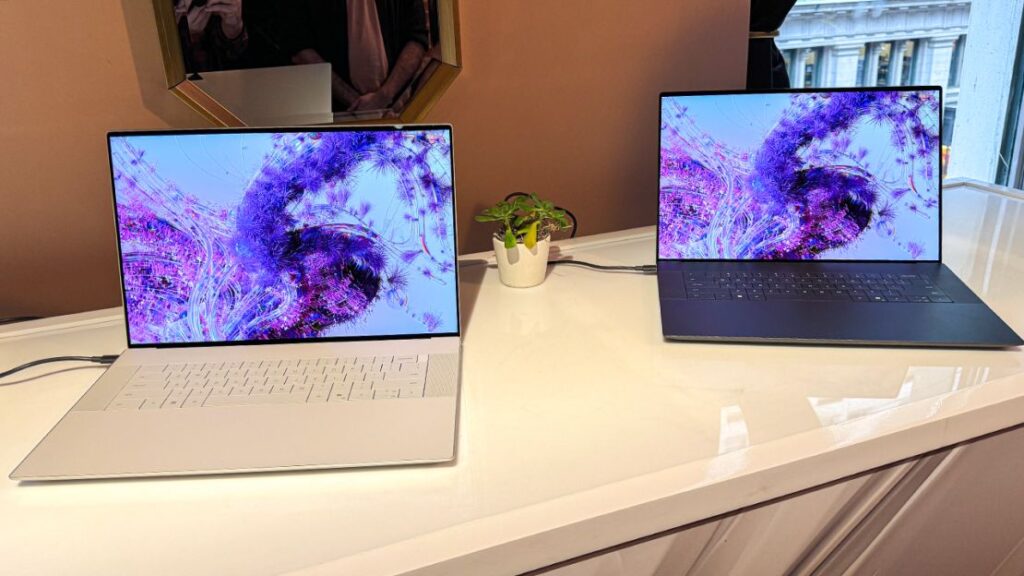
- Processor: Intel Core Ultra 7 155H, featuring 16 cores and 22 threads, including six high-performance cores, eight energy-efficient cores, and two low-power efficient cores, with a maximum clock speed of 5.1GHz.
- Graphics: Nvidia RTX 4070 with 8GB of GDDR6X memory (discrete, up to 60 watts), and integrated Intel Arc graphics.
- Memory: 32GB LPDDR5X running at 7467MHz (soldered onto the board)
- Storage: 1TB NVMe PCIe 4.0 SSD
- Screen: 16.3-inch OLED touchscreen with a resolution of 3840 x 2400 and a 90Hz refresh rate.
- Battery life: 12.5+ hours
Despite its unassuming appearance as a basic productivity laptop, the Dell XPS 16 is anything but ordinary.
With a robust processor and a powerful discrete graphics card, it excels at running physics simulations, complex programming tasks, intensive games, and even 8K video editing effortlessly.
The Dell XPS 16 is not only powerful but also visually stunning, featuring a beautiful 4K OLED screen within a sleek all-metal body that will definitely catch attention.
However, despite its many impressive qualities, its high cost is a significant drawback. Prices start at around $1,900, and if you’re looking for a model with discrete graphics and an OLED display, you could be spending $3,000 or more.
If you’re willing to sacrifice some of the Dell XPS 16’s sophistication, the Asus ROG Zephyrus G16 could be a great choice, especially considering it’s over $1,000 cheaper.
However, if you’re deciding between the XPS 16 and a MacBook Pro 16 with the M3 Max chip, the MacBook Pro 16 is more expensive, but it offers superior battery life and performance that only larger, more robust gaming or workstation laptops could rival.
Pros
- Attractive and sturdy design
- Strong performance and battery life
- Top-tier display and audio
Cons
- Heavy and thick
- Controversial keyboard function row
- Not the best value
Dell XPS 17 (2023)
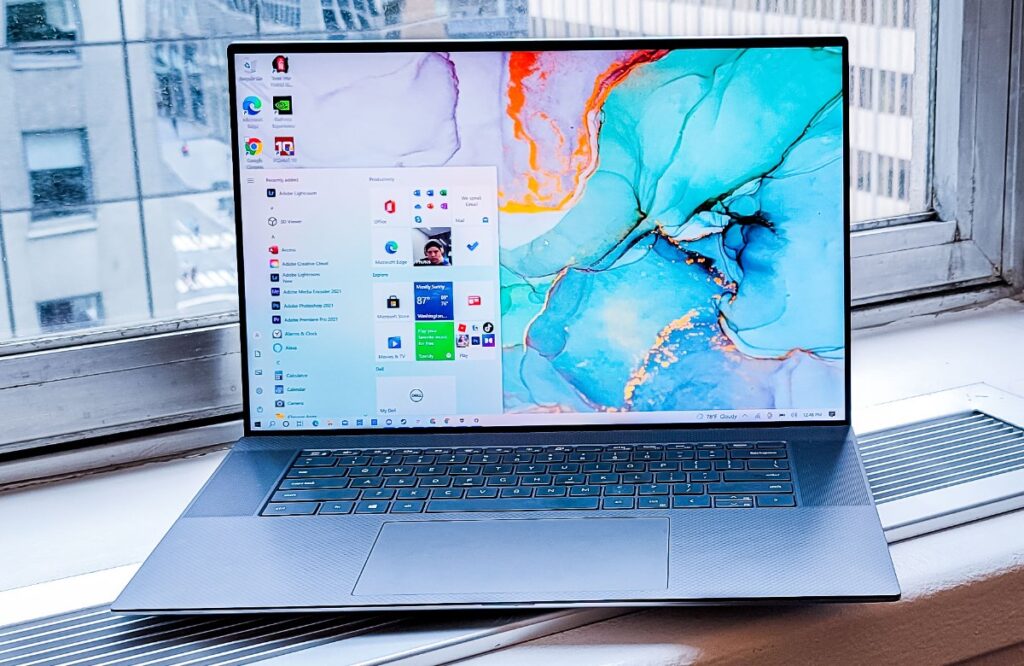
- Processor: Intel Core i7-13700H
- Visuals: Nvidia RTX 4070, Intel Iris Xe graphics
- Memory: 32GB LPDDR5
- Storage size: 1TB SSD
- Screen: 17 inches, 3840 x 2400 resolution, 60Hz refresh rate, IPS touch display
- Battery life: 14.5+ hours
The Dell XPS 17, while a bit older than the XPS 16, remains equally powerful and versatile.
Both laptops boast top-tier graphics cards capable of delivering frame rates near 100 fps in demanding games.
They also come with ample memory and storage space, as well as large displays.
However, the Dell XPS 17 is $650 more affordable than the XPS 16.
If you’re not into gaming but still require a powerful machine for intense processing tasks, the XPS 17 is an excellent choice for creatives who favor Windows over macOS.
It achieved impressive results in most of our benchmark tests, surpassing the Apple MacBook Pro 14 M2 Max in nearly all of them.
Pros
- Large, bright display
- Great CPU and SSD performance
- Attractive design
Cons
- Limited connectivity for older devices
- Modest graphics performance
Lenovo Slim Pro 7 14 (2023)
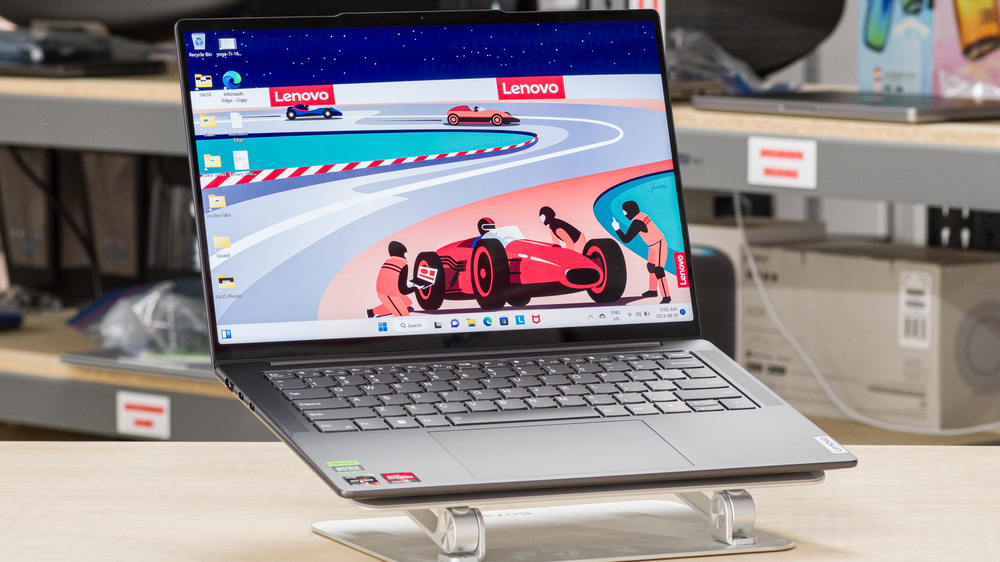
- Processor: AMD Ryzen 7 7735HS
- Graphics: Nvidia RTX 3050
- Memory: 16GB DDR5 6400MHz
- Storage size: 512GB SSD
- Screen: 14.5-inch, 2560 x 1600 resolution, 90Hz IPS touch display
- Battery life: 9.5+ hours
The Lenovo Slim Pro 7 14 is a versatile device that is perfect for handling the demands of school or work. It’s an excellent choice for those who want to stay within a budget without compromising on quality.
While it may not outperform a top-tier gaming laptop in terms of performance, it’s sufficiently robust for daily use.
The CPU has ample multicore capabilities to handle light creative activities such as photo, video, and audio editing.
Additionally, the basic discrete GPU renders images significantly quicker than AMD’s integrated graphics chip.
Furthermore, it is equipped with a range of diverse ports suitable for any computing scenario, whether for work or personal use.
Measuring less than an inch in thickness and weighing approximately 3.5 pounds, it boasts a battery life of nearly 10 hours.
This laptop includes all the features you would anticipate and performs all the functions you need.
Pros
- Solid performance
- Sturdy, tactile keyboard feel
- Minimalist, professional look
Cons
- Just okay screen brightness
- Loaded with bloatware
Acer Swift X 14 (2023)
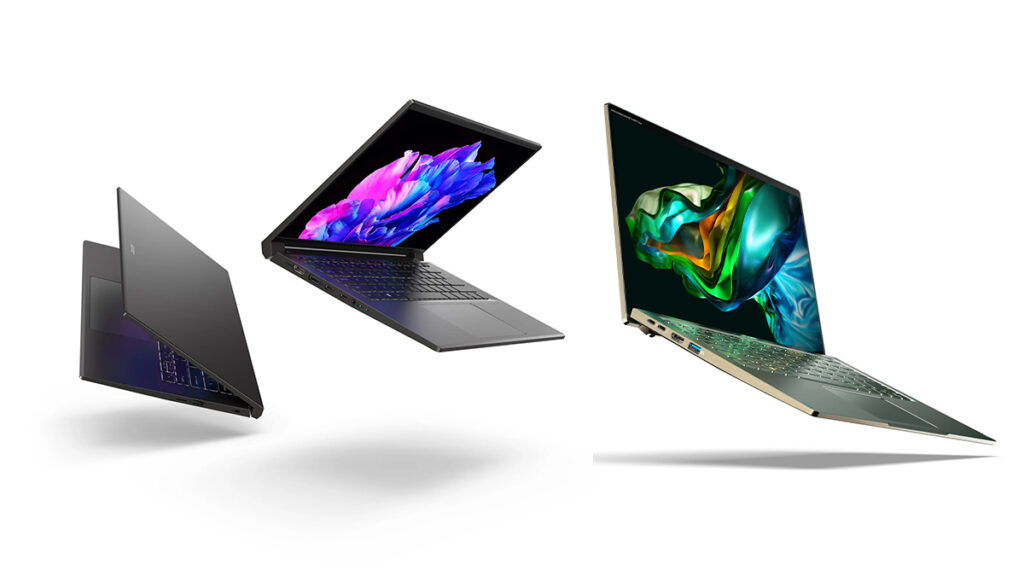
- Processor: Intel Core i7-13700H
- Graphics: Nvidia GeForce RTX 4050, Intel Iris Xe (built-in)
- Memory: 16GB LPDDR5 6400MHz
- Storage: 1TB SSD
- Screen: 14.5-inch OLED with a resolution of 2880 x 1800 pixels and a refresh rate of 120Hz.
- Battery life: ~7.5 hours
The Acer Swift X 14 offers impressive processing and graphics capabilities for a laptop that balances productivity and content creation.
While it may not be the fastest we’ve ever tested, its performance is more than adequate for everyday tasks, including photo and video editing as well as basic 3D image rendering.
It also boasts one of the best selections of connectivity ports among the laptops mentioned here and excels in reading and writing information to its SSD.
The screen showcases the strong, vibrant colors and rich, dark contrasts that are typical of OLED displays. In our review, we described the Swift X 14 as a “well-rounded package of high-quality components.”
Pros
- Impressive GPU performance
- OLED display with vivid colors
- Great selection of ports
Cons
- Disappointing battery life
- Oversized touchpad
- Underwhelming screen brightness
Lenovo Legion Slim 5 Gen 8 (14″, 2023)
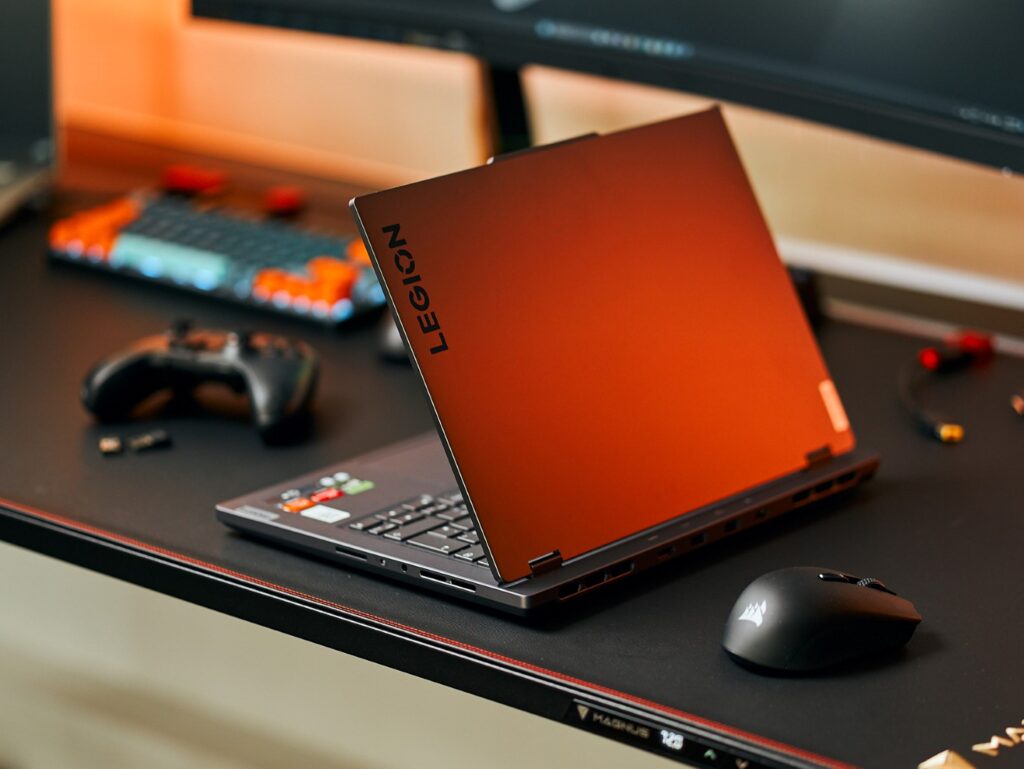
- Processor: AMD Ryzen 7 7840HS
- Graphics: Nvidia GeForce RTX 4060 with 8GB dedicated memory; AMD Radeon 780M integrated graphics
- Memory: 32GB LPDDR5X 6400MHz
- Storage: 512GB NVMe SSD with PCIe 4.0, M.2 2280 format; plus one additional empty M.2 2280 slot.
- Screen Specifications: 14.5-inch OLED display with a resolution of 2880 x 1800 and a refresh rate of 120Hz, featuring a glossy finish.
- Battery life: 8+ hours
The Lenovo Legion Slim 5 14APH8 is a powerful compact device.
Despite its small size and 14.5-inch display, it features a robust CPU and GPU combination that handles demanding tasks and games effortlessly.
This makes it an excellent choice for both gaming and productivity.
Even though it’s a powerful gaming laptop, it weighs less than 4 pounds and has a thickness of just 0.82 inches.
It features ample ventilation and delivers performance that frequently surpasses other slim and lightweight laptops with similar hardware.
Additionally, it offers commendable battery life, lasting around eight and a half hours in our standard battery test.
The Lenovo Legion Slim 5 features a crisp OLED screen that covers 100% of the DCI-P3 color space, providing outstanding visuals for gaming.
The display boasts a 120Hz refresh rate and quick pixel response times, making gaming a pleasurable experience.
If you intend to connect the laptop to an external monitor in a desktop configuration, it boasts numerous ports to facilitate that, including a full-sized HDMI 2.1 port.
Given all the features that the 2023 Legion Slim 5 14APH8 provides, it’s even more remarkable considering the price is approximately $1,000.
Pros
- Excellent design
- Performance and efficiency
- Gorgeous display
Cons
- The CPU can run hot
- No upgradeable memory
How We Test Laptops
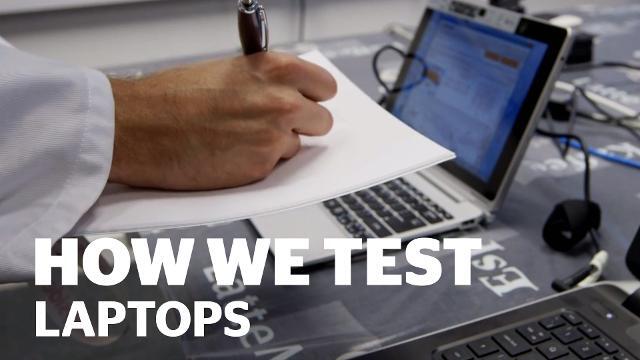
The Tests
At Reviewed, we evaluate laptops based on their processing power, graphics performance, battery life, and screen brightness.
To assess how efficiently a laptop can handle multitasking, gaming, and other tasks, we utilize well-known benchmarks such as Geekbench and 3DMark.
Our testing encompasses various platforms, including Windows laptops, Macs, and Chromebooks.
To evaluate battery life, we configure our laptops to repeatedly browse different websites at a screen brightness of 200 nits about 60% brightness for many mid-range models until the battery is fully depleted.
This helps us estimate how much you can accomplish on a single charge.
Additionally, we use each laptop for a long period, assessing factors such as build quality, cost, portability, and design.
What You Should Know About Laptops
When choosing a laptop, there are many factors to take into account. From the size of the screen to the construction quality, you’ll want to ensure you get a laptop that will serve you well for several years. Here’s what you should keep in mind:
Performance
The performance of your PC in multitasking, handling demanding activities like gaming, and storing files is governed by the CPU, graphics chip, RAM, and storage components.
Higher specifications will result in a more responsive and efficient laptop experience while you work.
Most individuals will find a current-generation Intel Core i5, Apple M3, or AMD Ryzen 5 processor to be more than sufficient, as these are mid-range options.
While 8GB of RAM should allow you to handle light multitasking comfortably, for those who require more intensive use, we suggest opting for 16GB or more.
If you’re involved in content creation, 32GB of RAM is ideal.
The requirements for graphics chips and storage capacity will differ significantly based on your intended use for the laptop.
Chromebooks can function well with 64GB of storage, supplemented by additional cloud storage. In contrast, Windows laptops generally require at least 256GB of storage to perform efficiently, with 512GB being an ideal choice for most users.
For the majority of individuals, having a separate graphics card isn’t necessary. Today’s integrated graphics can handle tasks like esports games and small-scale 3D modeling quite well.
Nonetheless, if you aim to play the newest high-end games or need to perform extensive vector computations, investing in a discrete graphics card would be advisable.
Build Quality
You not only need a laptop that can withstand rough handling (as you’ll likely be carrying it around a lot), but you also want one with a solidly built keyboard and trackpad, as these are your main ways of interacting with the device.
A subpar trackpad or unreliable keyboard can spoil the whole experience.
Typically, durable laptops are rigid and resistant to deformation, with metal often being tougher than plastic. A quality keyboard should allow for fast typing, with all keys easily accessible to your fingers to prevent mistyped keys.
Ensure that the Shift, Control, and Fn keys are conveniently positioned for your thumb and pinky fingers.
The choice between stiff or soft keys depends on your preference: stiff keys are less likely to be pressed accidentally but can lead to quicker fatigue, whereas soft keys are easier to type on for extended periods but may result in poorer feedback and more typos. Try out both to see which one feels most comfortable for you.
Judging trackpads is somewhat more straightforward.
A quality trackpad accurately detects all your finger movements, ensuring the mouse cursor moves smoothly without any jitters or lag.
Having a larger trackpad enhances your cursor control, and it should have minimal friction to prevent the cursor from “skipping.”
Touch Screens, Portability, and Features
2-in-1 devices have become more popular, though adding touch screens and styluses increases costs. Likewise, fitting all those high-performance components into a compact, portable design often results in a higher price compared to larger laptops with fewer design limitations.
They may not be as comfortable to use as dedicated tablets like iPads, but 2-in-1 devices offer additional flexibility for users who need a versatile option.
Stylus pens are particularly useful for people who frequently take notes or create drawings, such as students or artists.
Operating Systems
Think about which operating system you require.
Currently, Windows remains the leading OS, and if your plans include gaming, photo and video editing, or using specific work-related software, you’ll likely opt for a business laptop with Microsoft’s system.
On the other hand, MacOS offers unique software and excellent integration with the Apple ecosystem, making it the favored choice for individuals who own iPhones, iPads, or other Apple devices.
If you often find yourself using the internet and are looking to cut costs, a Chromebook could be a great option for you.
With access to Netflix, Gmail, and Google Docs, you can accomplish nearly everything directly through a browser.
Many web applications also have offline functionality for those uncommon moments when Wi-Fi isn’t available.
Chromebooks tend to be more affordable because they require less processing power and are almost entirely free of bloatware, as they operate on Linux.
Display Size
Laptops are typically available in three primary sizes, which are determined by measuring the diagonal length of the screen.
- Laptops that are 14 inches or smaller are ideal for portability and are perfectly adequate for tasks such as writing documents and surfing the internet.
- Laptops with a screen size of 15 to 16 inches are moderately less portable and might not be ideal for cramped areas such as airplane seats. However, this size is advantageous for activities like photo editing and video watching. Additionally, the larger body of these laptops can accommodate more powerful hardware.
- 17+ inches: This is a significantly large screen size, and it’s only advisable for use if you are engaged in tasks like video editing or other demanding work that necessitates ample screen space on your laptop – provided you’re okay with carrying the weight around.
You should also think about the number of USB ports you need, whether HDMI and Ethernet connections are necessary, and how user-friendly the keyboard and trackpad are these features can differ significantly between models, so it’s crucial to choose ones that are both responsive and durable.


